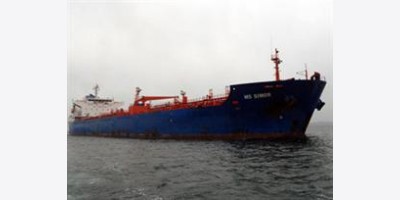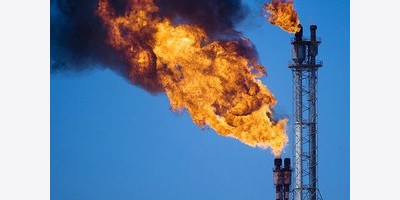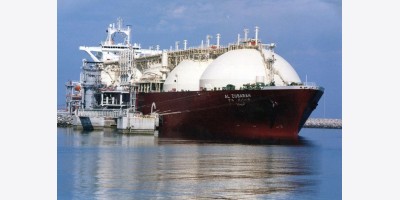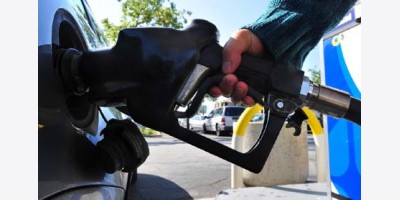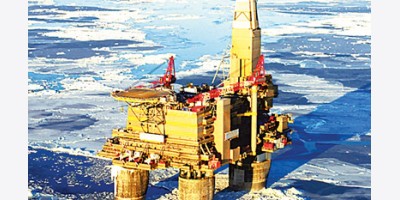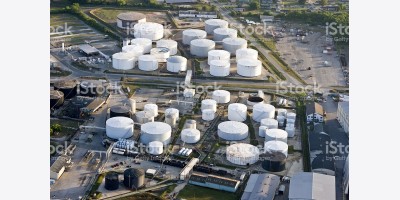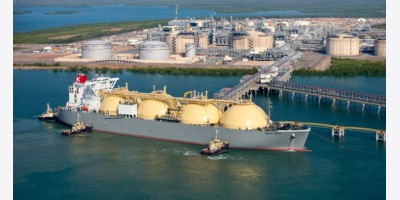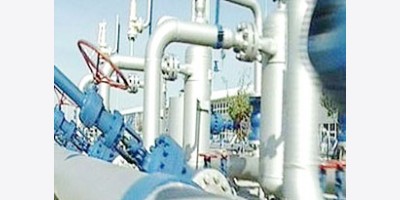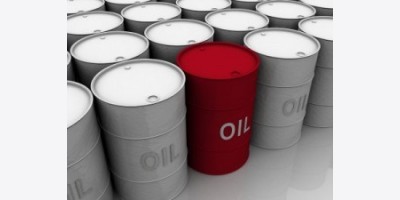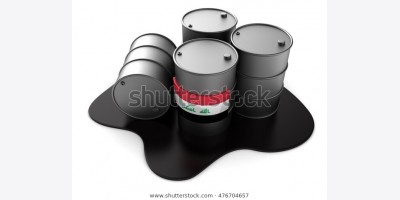By Mark Shenk Aug 25, 2014 6:01 AM GMT+0700
Speculators are the least bullish on U.S. crude oil prices in 16 months as refinery maintenance weakens demand at a time when Libya and Iraq are swelling global supplies.
Futures dropped a fifth consecutive week after money managers reduced net-long positions in West Texas Intermediate, the U.S. benchmark grade, by 14 percent in the seven days ended Aug. 19, the Commodity Futures Trading Commission said.
Prices sank below $95 on Aug. 19 for the first time in seven months as U.S. air strikes in Iraq helped reverse the advance of Islamic State fighters and the country’s Kurds work to increase oil shipments. Libyan output climbed last week and exports resumed from the port of Es Sider. Refineries in the U.S. typically schedule work for September and October, when demand for gasoline declines after the summer peak, and before consumption of heating fuel picks up during winter.
“It’s hard not to be bearish with the Kurds boosting shipments and more oil coming out of Libya,” Michael Lynch, president of Strategic Energy & Economic Research in Winchester, Massachusetts, said by phone Aug. 22. “The market isn’t getting any support from the geopolitical side now and supplies continue to increase.”
Crude declined 3 percent to $94.48 a barrel on the New York Mercantile Exchange in the period covered by the CFTC report, and closed at $93.65 Aug. 22.
Air Strikes
President Barack Obama will consider air strikes in Syria if needed in the battle against the Islamic State terrorists who beheaded an American journalist, deputy national security adviser, Ben Rhodes, told reporters Aug. 22.
The killing “appears to have galvanized the U.S., western Europe and other countries to adopt a unified stance against the guerrillas,” Tom Finlon, Jupiter, Florida-based director of Energy Analytics Group LLC, said by phone Aug. 22. “Not only have they have lost the ability to cut Iraqi oil exports but the Kurds have gained the ability to increase theirs.”
Iraq’s Kurds are working to quadruple the capacity of their oil-export pipeline within months, an official with knowledge of the situation said, asking not to be named because of policy. The Kurdistan Regional Government, or KRG, more than doubled daily capacity to 300,000 barrels on its link to Turkey as of Aug. 21, and is considering another increase that would allow the line to move 500,000 barrels a day to the Mediterranean port of Ceyhan within as little as three months, he said.
Libyan Production
In Libya, production increased to 612,000 barrels a day on Aug. 21, according to Mohamed Elharari, a spokesman for National Oil Corp. Two cargoes have loaded at the reopened port of Es Sider, according to the NOC. The North African country pumped 400,000 barrels a day in July, according to a Bloomberg survey of oil companies, producers and analysts.
The increase in crude supply from Libya and Iraq comes as the EIA forecasts U.S. production will reach 9.28 million barrels a day next year, the highest annual average since 1972.
The EIA in its Short-Term Energy Outlook released Aug. 12 estimated U.S. refineries will process 15.25 million barrels a day of crude in October, down from 16.42 million in July.
“WTI is weakening because we are approaching refinery turnaround season,” said Finlon.
Net-longs for WTI slipped by 30,225 to 188,589 futures and options, the lowest level since the seven days ended April 23, 2013. Long positions fell 4.2 percent 258,246, the least since June 2013. Shorts climbed 37 percent to 69,657, the highest level since December 2012.
Gasoline Bets
In other markets, bullish bets on gasoline fell 14 percent to 28,431 futures and options combined, the least since February. Futures declined 1.4 percent to $2.6954 a gallon on Nymex in the reporting period. They dropped 0.91 cent to $2.7384 on Aug. 22.
Regular gasoline at the pump, averaged nationwide, rose 0.1 cent to $3.437 a gallon Aug. 21, according to Heathrow, Florida-based AAA, the largest U.S. motoring group. Prices slipped to $3.436 Aug. 20, the lowest since Feb. 26.
“I don’t see a lot of upside in the gasoline market,” Tim Evans, an energy analyst at Citi Futures in New York, said by phone Aug. 22. “There may be a short-term spurt of demand but the market’s looking ahead to weaker fourth-quarter demand.”
Bearish wagers on U.S. ultra low sulfur diesel fell 40 percent to 7,828 contracts. The fuel decreased by 2.79 cents to $2.8171 a gallon in the report week.
Natural Gas
Net-long wagers on U.S. natural gas rose 14 percent to 149,608, the first gain since June. The measure includes an index of four contracts adjusted to futures equivalents: Nymex natural gas futures, Nymex Henry Hub Swap Futures, Nymex ClearPort Henry Hub Penultimate Swaps and the ICE Futures U.S. Henry Hub contract.
Nymex natural gas dropped 2.4 percent to $3.877 per million British thermal units during the report week. It fell 1.3 percent to $3.84 Aug. 22.
Members of the Organization of Petroleum Exporting Countries may curb output to keep prices from dropping further, BNP Paribas and Commerzbank said in reports last week. OPEC ministers kept their target unchanged at 30 million barrels a day on June 11 in Vienna. The group is scheduled to meet next on Nov. 27.
“With the increase in Kurdish shipments, Libyan output and rising production here, OPEC will have to consider taking some action to support prices,” Finlon said.
By Selcan Hacaoglu Aug 24, 2014 5:06 PM GMT+0700
Shipments of Iraqi Kurdish oil resumed from the Turkish terminal Ceyhan today as the Spanish-flagged tanker Ultimate Freedom completed loading and prepared to depart, according to an official with knowledge of the situation who asked not to be identified, citing policy.
The tanker loaded some 950,000 barrels and is expected to leave Ceyhan shortly, the official said by phone. Oil flow from northern Iraq restarted last week after a pause of more than two weeks while Iraqi Kurds installed a booster station to speed up the flow through the pipeline.
The Malta-flagged Phoenix AN and the Greek-flagged United Carrier tankers were on their way to Ceyhan on the Mediterranean cost to pick up some 250,000 and 500,000 barrels of Kurdish oil, respectively, the official said.
The Kurdish regional government’s press officer didn’t answer phone calls seeking comment today. Turkey has ignored objections by Iraq’s central government, which says the oil exports are illegal and must be stopped. Iraqi Kurds are also exporting crude on trucks via Turkey.
Aug 23, 2014 1:15 AM GMT+0700
Aug. 22 (Bloomberg) –- Iraq and the Kurdistan Regional Government must wait awhile longer for a U.S. judge to decide if he has authority to let federal agents seize $100 million worth of Kurdish crude waiting in a tanker off the Texas coast.
Lawyers for the Iraqi Ministry of Oil convinced a magistrate judge last month to issue an arrest warrant for the 1 million-barrel cargo if the tanker enters U.S. territorial waters. That order would let U.S. marshals store the oil ashore at Iraqi expense until the dispute is resolved.
U.S. District Judge Gray Miller, who now presides over the case, told lawyers at a hearing today in Houston federal court that he needs more time for his decision, which will turn in large part on where and when Iraq lost control of the oil.
If control of the crude changed when it was loaded onto the tanker in Turkey, Miller may have authority to decide the dispute under U.S. maritime laws governing property stolen at sea. If Iraq lost control of the crude when Kurds initially pumped it from oilfields in northern Iraq and exported it through Turkey in an Iraqi-owned pipeline, Miller said he would only have authority if the Kurds agree to submit to U.S. legal jurisdiction, which they’ve refused to do.
“The question is where we first exercised control over the oil and that happened in Iraq,” Harold Watson, a U.S. lawyer for the Kurdish government, said at the hearing on the KRG’s request to throw out the seizure order. “Is admiralty law going to govern this dispute? Of course not. This dispute is going to be governed by Iraqi constitutional law.”
Ownership
In court papers, both sides stated they’d prefer to settle the ownership issue in Iraq’s Supreme Court, where the national oil ministry is already suing the KRG on claims it illegally misappropriated oil that belongs to the national government.
The two sides are locked in a protracted legal fight there over rights to Kurdish oil production and billions of dollars in overdue payments the national government owes Kurdistan for war-crimes reparations and oil royalties. The U.S. government recognizes Kurdistan as part of Iraq.
“What we want is for that oil to be held pending the outcome of the litigation in Iraq, which is where it needs to be,” Phillip Dye, an American attorney for the Iraqi oil ministry, told the judge. “It’s the only hold we have over them. If this court allows this oil to be sold, they’re never going to show up in Iraq” so that court can determine if the KRG can legally export oil from Kurdish territory.
The case is Ministry of Oil of the Republic of Iraq v. 1,032,212 Barrels of Crude Oil, 3:14-249, U.S. District Court, Southern District of Texas (Galveston)
By Jessica Summers and Dan Murtaugh Aug 25, 2014 1:26 AM GMT+0700
The cheapest crude oil since January has refiners producing fuel at record rates, helping lower the cost of gasoline at pumps across the country.
The average price for regular gasoline at U.S. pumps dropped 4.21 cents in the two weeks ended Aug. 22 to $3.4785 a gallon, according to Lundberg Survey Inc. The average is based on information obtained at about 2,500 filling stations by the Camarillo, California-based company. Prices are 8.01 cents lower than a year ago, the survey showed.
Retail prices dropped as West Texas Intermediate crude futures fell below $94 a barrel. U.S. refiners are processing the most petroleum for this time of year in records dating back to 1989.
“It’s crude oil at work,” Trilby Lundberg, the president of Lundberg Survey, said in a telephone interview today. “The down factors outweighed the up factors. One of the many factors include robust U.S. oil production.”
The highest price for gasoline in the lower 48 states among the markets surveyed was in San Francisco, at $3.92 a gallon, Lundberg said. The lowest price was in Jackson, Mississippi, where customers paid an average $3.11 a gallon. Regular gasoline averaged $3.66 a gallon on Long Island, New York, and $3.79 in Los Angeles.
Cheap Crude
West Texas Intermediate crude, the U.S. benchmark priced in Cushing, Oklahoma, fell $4, or 4.1 percent, to $93.65 a barrel on the New York Mercantile Exchange in the two weeks to Aug. 22. It’s the lowest settlement since Jan. 14.
Refineries processed 16.42 million barrels a day in the week ended Aug. 15, the highest level for mid-August in Energy Information Administration records dating back to 1989. Refinery inputs reached a record 16.63 million barrels a day the week of July 11.
On the Gulf Coast, home to more than half of the nation’s refining capacity, rates rose to 8.74 million barrels a day the week of Aug. 15, the highest level on record.
Crude inventories nationwide fell 4.47 million barrels to 362.5 million, the lowest level since Feb. 21.
Gasoline Futures
Plants are taking advantage of the U.S. shale boom, which has raised oil production 64 percent in the past five years. The increased output has pushed the settlement price of U.S. benchmark WTI futures below European Brent every day since Aug. 17, 2010.
Gasoline futures on the Nymex slipped 1.53 cents, or 0.6 percent, to $2.7384 a gallon in the two weeks ended Aug. 22.
Gasoline stockpiles grew 585,000 barrels to 213.3 million, EIA data show. Demand over the four weeks ended August 1 was 9.016 million barrels a day, 2 percent below a year earlier.
By Adam Williams and Brendan Case Aug 23, 2014 11:00 AM GMT+0700
Petroleos Mexicanos, the crude producer that accounts for about a third of state revenue in Mexico, said it pays taxes on oil production volume that’s inflated by water and other measurement inaccuracies.
Under existing law, the company known as Pemex pays some taxes based on reported volume at the wellhead, it said by e-mail yesterday. In the statement, Pemex cut its year-to-date production to 2.34 million barrels a day from a previously reported 2.47 million. Output was overstated because of water content and inefficient measuring and separation systems.
“The water content and measurement distortions have increased the fiscal burden on Pemex,” the Mexico City-based company said in the statement.
Facing a 10th straight year of production declines, Pemex said output at the end of the year would be about 2.35 million barrels a day. That’s the second revision in a month after Exploration and Production Director Gustavo Hernandez cut the forecast to 2.44 million barrels from 2.5 million on July 25 and comes as Pemex negotiates partnerships with private producers for the first time in seven decades.
“This is something that had been rumored for a long time, so the announcement is welcome news,” Marcelo Mereles, a former Pemex executive who’s now a partner at energy consulting firm EnergeA, said in an interview in Mexico City. “It’s good that Pemex is announcing this in a direct way and being very transparent about it. Further explanation will be required.”
Bond Rally
Pemex’s $2.1 billion of bonds due 2023 rose yesterday for the ninth time in 10 days, pushing down the yield to 3.8 percent, according to data compiled by Bloomberg.
Production through June was reported as 2.48 million barrels a day, while the volume the state-owned company processed was 2.32 million barrels a day, according to the National Hydrocarbons Commission.
That record gap is partly explained by measuring systems at older fields that are unable to differentiate water-heavy oil from actual crude, a company official briefed on the matter said last week. Some wells at the Cantarell field are producing as much as 25 percent water, Hernandez said Aug. 13.
Pemex said today that 14,000 barrels a day this year were lost to evaporation, 9,000 to product segregation and 6,000 to inventory losses.
The company is working to improve equipment calibration to reduce miscalculations and installing sedimentary tanks to accelerate dehydration and stabilize crude, in accordance with international specifications.
By Lynn Doan and Richard Stubbe Aug 23, 2014 3:30 AM GMT+0700
The number of rigs targeting oil in the U.S. shrank this week by the most since 2012 as crude trades at a seven-month low and drillers redirect equipment to focus on the most profitable plays.
Oil rigs tumbled by 25 this week to 1,564, the lowest level in a month and the largest drop since Dec. 21, 2012, data posted on Baker Hughes Inc. (BHI)’s website today show. Those targeting gas meanwhile jumped to the highest in five months, the Houston-based field services company said. U.S. benchmark West Texas Intermediate crude declined for a fifth week, the longest losing streak in nine months.
Lower prices threaten to halt a surge in the oil rig count as energy producers use a combination of horizontal drilling and hydraulic fracturing to draw record volumes out of shale formations from North Dakota to Texas. The shale boom has raised domestic production to the highest in 27 years and cut U.S. imports to the lowest seasonal level since 1993. Oil rigs reached a record just last week.
“The primary reason you see changes in the count is scheduling, so operators who have wells throughout different plays are moving rigs as they change targets,” said Evan Turner, energy analyst at the London-based research company GlobalData Ltd. “This is a big move in the count, so it’s likely a combination of that and lower-than-anticipated oil prices. It may be that they target less oil now and go for gas.”
Oil Production
West Texas Intermediate crude for October delivery declined 31 cents, or 0.3 percent, to settle at $93.65 a barrel on the New York Mercantile Exchange, down 11 percent in the past year.
“We’ve got oil prices down 10 percent in the last two months, so it’s about time we started seeing some effect on drilling,” James Williams, president of energy consulting company WTRG Economics in London, Arkansas, said by telephone. “We might be back up next week, but there’s going to be downward pressure on oil drilling and most of the pressure is going to be on locations where we’re getting a lower-than-average price for oil.”
Oil production rose 21,000 barrels a day in the week ended Aug. 15 to 8.58 million, Energy Information Administration data show. Output reached the highest level since 1986 in the week of July 11.
Gas Inventories
U.S. gas stockpiles increased 88 billion cubic feet last week to 2.555 trillion, below the five-year average, according to the EIA.
Natural gas for September delivery fell 4.9 cents, or 1.3 percent, to $3.84 per million British thermal units today on the Nymex, up 8.3 percent in the past year. Oil is trading at 24 times the price of gas, down from almost 28 a month ago.
Total rigs fell by 17 to 1,896, Baker Hughes said. Those drilling for oil made up 82.5 percent of the total count, its smallest share since June 6.
Energy rigs dropped the most in the Permian Basin of Texas and New Mexico, the biggest onshore oil play in the U.S. The count fell by three there to 555. Rigs in Texas’s Eagle Ford formation meanwhile gained one to 200.
“It looks likely that they’re trying to target prospects in the Eagle Ford if they have holdings in each of those plays,” Turner said by telephone from New York. “The Eagle Ford has more potential.”
To contact the reporters on this story: Lynn Doan in San Francisco at ldoan6@bloomberg.net; Richard Stubbe in Houston at rstubbe1@bloomberg.net
By Lananh Nguyen Aug 22, 2014 3:53 PM GMT+0700
European refiners are already enduring the worst slump in decades. A growing heating-oil glut is about to make it worse.
Profit this year will be the lowest since 2011 because of competition from heating-oil imports, according to Wood Mackenzie, a consulting company. Inventories in Amsterdam-Rotterdam-Antwerp, the center of European trading, are the highest for the time of year since 2009, according to data from PJK International BV, a researcher in the Netherlands.
“We’re looking at very weak margins,” Jonathan Leitch, a senior analyst at Wood Mackenzie in London, said by phone yesterday. “Summer has been disappointing. If you think that hasn’t been great, wait until you get to autumn and winter.”
European refineries are shutting or converting to storage depots at the fastest pace since the 1980s as demand for oil products dropped for seven years and competition from U.S., Russian and the Middle Eastern supplies intensified. Seventeen plants closed in the past six years, says the International Energy Agency, the Paris-based adviser to 29 nations.
The profit for a refinery in the region able to maximize production of higher-value fuels averaged $1.27 a barrel from May to July compared with $2.83 in the same period a year earlier, based on the price of Brent crude, according to Wood Mackenzie. By December, it will turn into a loss of 80 cents a barrel, the forecast shows.
Refining Margins
Lower summer profits combined with winter losses mean the refining margin in the region will average 40 cents for 2014, less than half the profit last year and just 10 percent of the level in 2012, according to Wood Mackenzie.
“It’s very difficult for many European refiners to compete,” Ehsan Ul-Haq, a senior market consultant at KBC Energy Economics in Walton-on-Thames, England, said by phone yesterday. “Part of the refining capacity has to be closed.”
Eni SpA, Italy’s largest oil company, is negotiating with unions to shut more than half of its 774,000 barrels a day of refining capacity, putting more than 3,500 jobs at risk. The sector employs about 100,000 people, according to FuelsEurope, an industry group.
About 1.5 million barrels a day of capacity will need to be closed to eliminate the continent’s glut, Patrick de la Chevardiere, chief financial officer of Total SA, Europe’s biggest refiner, said last month. That would bring the cumulative reduction in Europe’s developed economies to 2.8 million barrels a day -- more than the fuel consumption of Germany -- from a total of 15.9 million at the start of 2008, according to Bloomberg calculations based on IEA data.
Fuel Surplus
Gasoil stockpiles in the Amsterdam-Rotterdam-Antwerp area almost doubled in the four months to yesterday to 2.74 million metric tons, according to PJK data.
Front-month gasoil futures slumped to a 14-month low of $852.50 a metric ton ($2.278 a gallon) on Aug. 18 on the ICE Futures Europe exchange and traded for at $861.25 at 9:52 a.m. in London. The contract is used in Europe to derive the price of oil products called middle distillates, including heating oil, diesel and jet fuel. Gasoil’s crack, or premium to European benchmark Brent crude, narrowed 14 percent this year to about $13.50 a barrel.
Margins might improve in September and October as plants halt in Europe and Russia for maintenance, shutting about 1.1 million barrels of capacity on average, KBC estimated. While cold temperatures might spur higher consumption and erode the heating oil surplus, “I don’t think that we will see significant improvement in demand,” said Ul-Haq.
Markets Shrink
Daily fuel consumption in the region’s most-developed economies fell to 13.22 million barrels in May, down 3.2 percent from an average of 13.7 million last year, according to IEA data published Aug. 12. This year’s drop in consumption is smaller than “heavy falls” over the past three years, the IEA said.
Refiners’ profits tend to peak in the summer as vacationers and truckers travel more. Margins from making gasoline were lower this year as production surged in the U.S., northwest Europe’s main export market.
U.S. gasoline production climbed to a record 9.84 million barrels a day in the week ended June 13, according to data from the U.S. Energy Information Administration. The country imported 550,000 barrels a day of gasoline on average this year, compared with 1.1 million in 2006, according to EIA data.
U.S. Advantage
North American refiners have the advantage of abundant supplies of cheap oil produced from shale deposits. West Texas Intermediate, the U.S. crude benchmark, traded at a discount of almost $9 a barrel to Brent yesterday on ICE.
The “spectacular renaissance” in U.S. refining has combined with a surge of exports from Russia, the IEA said in a June report. Companies are refining more crude after President Vladimir Putin pushed them to spend billions of dollars modernizing plants. Output of diesel and fuel oil were the highest in June since at least 2009, Energy Ministry data show.
Middle Eastern refining capacity will rise 2.2 million barrels a day by 2019 as large new projects come online, the IEA said. “Feedstock costs are much lower in the Middle East and most of the new refineries are very sophisticated,” making it hard for European plants to remain competitive, Ul-Haq said.
Imports will expand Europe’s glut, Steve Sawyer, an analyst at FGE, an energy consultancy, said by phone from London Aug. 20. The region imported 1.2 million barrels a day of gasoil and diesel in April, up 34 percent from a year earlier, according to IEA data.
“When you look at Europe, it’s caught in this pincer,” Sawyer said. “It’s pressure from all sides. The pressure is going to continue.”
By Aibing Guo Aug 23, 2014 3:00 AM GMT+0700
China Petroleum & Chemical Corp. (386) posted a better-than-expected 7.5 percent increase in first-half profit as Asia’s biggest refiner widened the margin it earns from processing crude oil into fuels.
Net income rose to 32.5 billion yuan ($5.3 billion), or 0.28 yuan a share, 30.3 billion yuan, or 0.25 yuan, a year earlier, the Beijing-based company, known as Sinopec, said yesterday in a filing to the Shanghai stock exchange. The average of six analyst estimates, compiled by Bloomberg, was a profit of 30 billion yuan.
Sinopec is at the forefront of a China government push to restructure state-controlled companies and allow markets a bigger role in the allocation of resources. The company is seeking to raise 100 billion yuan selling about a third of its retail unit.
“Cost efficiency has kicked in for refining and the turnaround should be very sustainable,” said Gordon Kwan, head of oil and gas research at Nomura International Hong Kong Ltd. “The second half could be better as they are fine-tuning their product mix as well as deploying their capital more wisely.”
Refining margin, defined as sales minus crude oil and feedstock costs plus taxes, other than income tax, divided by crude oil throughput and feedstock, rose by 90.8 yuan a metric ton to 300.3 yuan, according to the company’s interim report. Operating profit for refining operations climbed almost 46 times to 9.76 billion yuan in the period from a year earlier, according to the filing.
The company’s shares advanced 1.6 percent to close at HK$7.71 in Hong Kong yesterday, before the earnings statement .
Production Climbs
Oil and gas output rose 8 percent to 237 million barrels of oil equivalent, while total sales declined 4.2 percent to 1.36 trillion yuan. Capital expenditure was 39.2 billion yuan in the first half, with 20.7 billion yuan spent on exploration and production.
Shale gas production reached an average of 3.2 million cubic meters a day at Fuling, China’s biggest shale-producing project, in Southwest China’s Chongqing.
The average price for Brent, the benchmark for half of the world’s crude, rose to $108.82 a barrel in the period from $107.88 a year ago, according to data compiled by Bloomberg.
The refiner is the first among China’s three biggest oil companies to report semi-annual results. PetroChina Co. (857), the country’s biggest oil and gas producer, and Cnooc Ltd. (883), China’s biggest offshore oil and gas explorer, are both scheduled to publish first-half earnings on Aug. 28.
Mexico City (Platts)--22Aug2014/631 pm EDT/2231 GMT
Mexican state Pemex has revised its annual production target for the year to 2.35 million b/d from 2.44 million b/d, its lowest level for three decades, the oil and natural gas monopoly said Friday.
January-through-July production data has been reduced by 126,000 b/d, or 5%, because of miscalculations by antiquated measuring equipment, Pemex said.
Water had been counted as oil in the calculations, it added.
Bogota (Platts)--22Aug2014/508 pm EDT/2108 GMT
Colombian crude oil production in July slipped to 968,000 b/d, a 5.1% drop from the 1.02 million b/d pumped in July last year and down 4% from June's 1.008 million b/d, according to a statement issued Friday by the mining and energy ministry.
Year to date, crude output has averaged 979,000 b/d, a 2.8% decline from the 2013 average of 1.007 million b/d.
Natural gas production in July averaged 1.072 billion cubic feet/d, down 10.2% from 1.193 Bcf/d a year earlier and down 3.3% from the 1.108 Bcf/d produced in June. Fluctuations in Colombia's natural gas output are mainly due to seasonal variations in domestic demand.
GENERAL STRIKE THREATENED AS UNION AGREEMENT ENDS
The ministry blamed the decline in oil output on bombings of the Cano Limon-Covenas pipeline, which connects the 80,000 b/d Cano Limon oil field with the Covenas offloading depot on the Caribbean. The pipeline has been attacked more than 60 times this year.
The suspension of pipeline activity there also meant that the 110,000 b/d Bicentennial Pipeline, which connects heavy oil fields in the Llanos region by tying into the Cano Limon line at Banadia, had to be shut.
The statement also cited the downing of a power line to the Rubiales heavy oil field, as well as scheduled maintenance at the Chichimene and Castilla oil fields operated by state-controlled Ecopetrol in eastern Meta province, among the nation's top producing blocks.
Colombia could face further disruption of its hydrocarbons output with the expiration Friday of its 10-year collective bargaining agreement with its biggest oil worker unions. Workers are threatening a general strike unless industry and union negotiators can come to terms.
In 2004, the industry suffered through a 37-day strike by unions until an agreement was finally signed. The unions represent roughly 40,000 direct and indirect workers.
ATTACKS COST UP TO 30,000 B/D; 'SHOCK PLAN' TO BOOST OUTPUT
The surge in pipeline attacks this year by suspected leftist guerrillas have cost the country as much as 30,000 b/d of oil production, according to the ministry.
Labor strife and community protests that have shut several oil fields at various times this year have also taken their toll.
The government was projecting 2014 crude output of close to 1.1 million b/d, with the associated income targeted for ambitious social programs and infrastructure projects. Finance ministry officials have said in recent days the government may have to raise taxes to make up for the shortfall in royalty and tax revenues.
The decline in oil production was a prominent theme at a special cabinet meeting hosted last weekend by Colombian President Juan Manuel Santos at the Hato Grande estate, Colombia's equivalent of Camp David.
After the meeting, finance minister Mauricio Cardenas told reporters that the government was developing a "shock plan" to revive petroleum output growth with the goal of assuring average 2014 output of at least 1 million b/d.
"It's a priority and a necessity because petroleum and the resources it generates are what permit the making of social policy," Cardenas said, as quoted in the El Tiempo newspaper on Wednesday.
Suspected rebels have also stepped up attacks on tanker trucks hauling crude in remote areas where no pipelines exist, causing significant environmental damage in southern Putumayo province and elsewhere.
The bombing of the dedicated electric power line to the Rubiales field, Colombia's biggest producing block, plus other incidents led to as much as 7,000 b/d of lost output in the second quarter, operator Pacific Rubiales Energy said during an earnings call this month.
President Santos has threatened to halt peace negotiations now underway in Havana between members of the government and the FARC insurgent group, if the attacks continue.
New York (Platts)--22Aug2014/353 pm EDT/1953 GMT
ICE October Brent fell 34 cents to close at $102.29/barrel Friday as the market comes to grip with a growing surplus of supply.
NYMEX October crude settled 31 cents lower at $93.65/b. NYMEX September RBOB finished 91 points lower at $2.7384/gal, while September ULSD settled 96 points lower at $2.8279/gal.
Barclay's analysts pointed to the deluge of light, sweet crudes on the global market to explain the current bear run in ICE Brent. The front-month contract traded as low as $101.07/b Tuesday, levels not seen since late-June 2013.
"Brent reached new 2014 lows this week as light quality crudes continued to swamp the market," they said. "The flood of Libyan barrels into the global market has pressured other light grades, including WAF and North Sea crudes."
Demand, meanwhile, is not keeping pace, Mike Fitzpatrick, editor in chief of the Kilduff Report, said.
"Brent crude oil prices continue to be buffeted by the growing supply and diminished prospects for the European economy and possible signs of slowing in China's industrial sector," he said.
The market largely dodged elevated tensions in Ukraine Friday. Ukraine security chief Valentyn Nalyvaychenko called the Russian aid convoy which entered Ukraine Friday without a Red Cross escort a "direct invasion," AFP reported.
The EU labeled the Russian move a "clear violation" of Ukraine's sovereign territory.
Tight distillate supply in the US was helping support front-month ULSD, Fitzpatrick said. "US distillate fuel inventories remain low, and the export push will likely keep it so," he said.
US Energy Information Administration data Wednesday showed combined low and ultra low sulfur diesel stocks on the US Gulf Coast fell to just over 31 million barrels last week, putting them more than 22% below the five-year average.
--James Bambino, james.bambino@platts.com--Edited by Derek Sands, derek.sands@platts.com
Lagos (Platts)--22Aug2014/1014 am EDT/1414 GMT
Nigeria lost Naira 38.88 billion ($243 million) worth of oil products last year from sabotage to the country's pipeline network, state-owned oil company NNPC said.
Thieves punctured 3,571 lines in Nigeria's network of 6,000 state-owned pipelines, up from 2,230 in 2012, when the product loss came to about Naira 21.48 billion, NNPC CEO Joseph Dawha said in a speech at an industry conference in Abuja.
"These acts have resulted to loss of revenue by the government and production capacity at our refineries," Dawha added.
He said the government would need to develop "critical infrastructure and key resources protection" in line with that of the US, and also called for an increase to prosecution rates in theft cases.
Nigeria's four state-owned refineries operates far below their capacity partly due to the frequent sabotage of the crude pipelines that feed into the plants.
NNPC data released this week showed that the refineries operated at an average of 15% of their combined nameplate capacity of 445,000 b/d in the first quarter of this year, down from 22% at the end of last year.
London (Platts)--22Aug2014/944 am EDT/1344 GMT
European refinery margins have found support from recent weak crude values, sources said Friday.
Refining margins in NWE have improved markedly over recent weeks on the back of a weakening Dated Brent price. The cracking margin for Ekofisk in NWE increased from minus $2.41/b on January 22 to plus $6.685/b on July 14, and is currently hovering just below that level at plus $5.14/b.
However, the strength in margins has been attributed to low crude oil prices, rather than a strong performance by the product market, leading some traders to question the sustainability of the trend.
"Margins are good, but they are led by weak Dated Brent, and not by strength in products," a crude oil trader told Platts. "Refiners should be looking to buy and fill their tanks, but they are already mostly long in terms of crude in tank."
A second trader described margins further out as "still pretty awful." Other traders also highlighted the trend in forward margins. "Margins are good now, and the question is whether refiners will ramp up runs," another crude trader said. "The forward margins are not looking good at all."
Diesel cracks have continued to gain ground over August, on stronger regional demand, both from seasonal consumption and opportunities of economising structural paper opportunities on the forward curve through storage plays ahead of the fourth quarter.
Spot ULSD FOB Rotterdam barge crack differentials to Dated Brent were $16.68/barrel Thursday, $1.54/bl above the 2014 average so far, but down $1.46/bl compared with the same period last year, according to Platts data.
Meanwhile, high sulfur vacuum gasoil, a hydrocracker feedstock used to make diesel, has suffered from a lack of demand owing to better crude margins and refinery maintenance on secondary units, sources said.
FOB NWE HSVGO cargo cracks were assessed at a $20.02/b discount to comparative diesel cargo cracks Thursday, the widest discount since December 7, 2012, Platts data shows.
"FCC and hydrocracker margins are excellent. The problem is though, you still have to find a buyer for your VGO. There are still so many units down for one reason or another and the supply is so relentless that VGO values have collapsed," a source said Friday. Stronger Jet cracks also continue to give refiners an incentive to maximise the higher quality grade product ahead of distillates where possible, lending some modest support to diesel.
"Jet/diesel is also moving in the direction to lose [jet] yield for the balance month, and certainly for September onwards I would expect more yield loss to diesel," a jet trader said.
Comparing prompt physical assessments, there remained an immediate incentive to maximize jet output. Jet FOB Rotterdam barges were assessed $0.58/b over ultra low sulfur diesel Thursday, on a density adjusted basis. For prompt CIF NWE Cargoes, diesel was $0.19/b over jet.
However, with September diesel swaps overtaking jet swaps on a density-adjusted basis last week, the return of higher diesel runs next month may present a ceiling for premiums in Europe. The outlook over the final quarter of this year show cracks down for diesel on a year-on-year basis. In the forward crack swaps market, ULSD FOB Rotterdam barge crack swaps for Q4 14 were $14.79/bl Thursday, $5.20/bl below year-ago levels.
KRG pipeline capacity to Turkish border seen reaching 400,000 b/d in Q1 2015
Development of the Kurdistan Regional Government’s export pipeline system is on track to deliver as much as 400,000 b/d of crude to the Turkish border in the first quarter of 2015, Anglo-Turkish Genel Energy said late Thursday.
A new pump being installed in northern Kurdistan at Fishkabour would soon bring the pipeline’s throughput capacity near the Turkish border to the nameplate 300,000 b/d of its design specification, Genel spokesman Andrew Benbow told Platts.
The line’s current capacity was unclear because planned pumping equipment was still being added and throughput had not yet been tested at much above 120,000 b/d, he added. “The line’s capacity isn’t really being tested yet because the production hasn’t been there,” Benbow said.
“But the aim is to do 400,000 b/d to Turkey in early 2015.” Pumping equipment to allow greater crude throughput was still being installed according to plan, he said Genel, the largest producer of crude from Iraqi Kurdistan, holds a 44% working interest in the region’s Taq Taq oil field and 25% in the Tawke field, which between them currently supply the bulk of the oil flowing through the KRG pipeline.
The company is not currently making public its projections for future output from either field, but would not dispute a recent estimate provided by Taq Taq joint venture operating company TTopco that total production from the Taq Taq field could reach 140,000 b/d by the end of August, up from a little over 100,000 b/d currently, Benbow said.
Pipeline capacity on the branch of the KRG export pipeline system connected to Taq Taq was on track to reach 200,000 b/d in 1Q 2015, he added. TTopco’s partners are Genel and the wholly-owned Addax Energy unit of China’s Sinopec.
Following disclosure Thursday by Norway’s DNO, which operates the Tawke field, that it had received KRG clearance for direct marking of Kurdish crude to international buyers without going through a regional marketing organization, Benbow said Genel was also holding “constructive discussions” on international oil marketing with the KRG.
Provisional Novorossiisk Sep 1-10 exports up 544,000 mt on Aug 1-10
Loadings of Urals crude out of the Black Sea port over the first decade of September are set to more than double over the same period in August, according to a copy of the provisional loading schedule for the grade seen by Platts Friday.
Exports are set to surge by 544,000 mt over the first 10 days of September to 1.004 million mt, with the average daily loading rate set to climb by 393,312 b/d to 725,892 b/d. August’s full loading program was the smallest since at least January 2012, according to Platts data, with a particularly tight first decade.
Only one Suezmax cargo of 140,000 mt and four Aframax cargoes of 80,000 mt each were scheduled over the the first 10 days of August. By contrast, Friday’s provisional schedule currently contains four Suezmax cargoes -- one cargo of 145,000 mt and three of 140,000 mt -- and five Aframax cargoes of 80,000 mt each.
An additional volume of 39,000 mt of small producers’ equity is included in the provisional schedule, and may be incorporated into another cargo at a later date. Provisional schedules are subject to change. Little additional information was released for the September Baltic Sea program with Friday’s provisional schedule.
Exports out of the Baltic Sea port of Primorsk are only included up through September 8, with one additional cargo scheduled on the provisional 1-5 schedule released late last week, though a number of the laycans are now carrying cargoes assigned to different equity holders. The additional cargo is of Lukoil equity for loading on September 7-8.
The nine cargoes currently scheduled to load over the first eight days of the month are unchanged from the same period of August. There were no further revelations about the loading schedule out of the nearby Baltic Sea port of Ust-Luga, with only the first six days of the September program currently available. One cargo of Siberian Light crude is currently scheduled to load out of Novorossiisk in the first decade of September, unchanged from the same period of August. Typically two to three cargoes a month of Siberian Light load from Novorossiisk. The final full August loading program ultimately had four, evenly distributed across the calendar.
Russia’s Rosneft signs asset-swap deal with Seadrill, NADL
Russia’s largest oil producer, Rosneft, has signed a framework agreement with Seadrill and North Atlantic Drilling, or NADL, that envisages the acquisition by Rosneft of NADL shares through an exchange of assets and investment in NADL’s charter capital, the Russian company said Friday.
The agreement’s options also envisage the possibility of Rosneft increasing its stake in NADL, a leading drilling company specializing in operations in harsh weather conditions, it said. NADL is majority owned by Norway- and US-listed Seadrill.
Final parameters of the deal, including the size of Rosneft’s cash contribution to NADL’s charter capital, will be defined on receiving corporate and accountant approvals which are expected by the end of 2014, it said.
The deal follows an initial agreement between the companies in May amid concerns about how US and EU sanctions over Ukraine -- banning the transfer of western technology and equipment needed for oil drilling in the Arctic, deepwater drilling and shale oil drilling -- might affect the company’s operations.
Rosneft did not disclose any parameters of the deal, but CEO Igor Sechin said in May, when the initial cooperation agreement was signed, that the deal envisioned Rosneft buying “a significant stake” in NADL, with the service company entering Russia’s onshore drilling market.
The oil producer might raise its stake to 50%, he said then, adding that cooperation with NADL was strategic, allowing Rosneft to “gain access to the technologies, skills and equipment needed for our offshore drilling program,” which would reduce the risk of Rosneft postponing the program due to a lack of platforms.
Friday’s agreement “will allow Rosneft to acquire new capabilities in the sphere of oilfield services, by engaging the best professionals, with unique expertise in operations in harsh weather conditions,” Sechin was quoted as saying in a statement.
“The company will strengthen its position significantly in the high-technology oilfield services market alongside leading global players in the sector,” he said. NADL shares are listed on the NYSE and the Oslo stock exchange with a market value of around $2.4 billion.
China’s Iranian crude imports in July surge 41% on year to 561,000 b/d
China’s crude imports from Iran in July surged 40.6% year on year to 2.37 million mt or an average 561,162 b/d, detailed trade data from the General Administration of Customs showed Friday.
The volume last month also rose 8.7% from June. This brought China’s crude imports from the country during the first seven months of the year to 17.94 million mt, or an average 620,164 b/d, surging by 5.73 million mt or 47% year on year.
It was the highest volume over the seven-month period since 2007 when Platts started tracking the data. The strong growth of Iranian imports over January to July offset the decrease of crude from Saudi Arabia, which remained China’s largest crude supplier.
Over the first seven months, Saudi shipments to China fell 13.5%, 4.34 million mt on year to 27.91 million mt. In July, crude imports from the country also dropped 28.9% on year and 4.3% on month to 3.75 million mt. China’s imports of crude from Oman also slumped by 39.9% on year and 27% on month in July to 1.98 million mt. As a result, total shipments from the Middle East in July declined by 10% year on year to 12.75 million mt, accounting 54% of China’s crude imports.
Elsewhere, the data showed China’s first import of crude from Papua New Guinea
in July, at 77,278 mt. China’s total crude imports from Latin America in July rose 11% year on year to 2.45 million mt. Major suppliers from the region were Brazil, Colombia and Venezuela. Due to less Angolan shipments, China’s crude imports from African dipped 7% in July from last year to 5.26 million mt. China imported 2.81 million of crude from Angola last month, down 18.3% from 2013. China’s African crude supplies last month accounted for 22% of its total imported volumes, down from 24% in July 2013.
Official: Iran to Boost Oil Products Storage Capacity
TEHRAN (FNA)- An Iranian energy official underlined that construction of more storage facilities has always stood atop the oil ministry's agenda, and said Iran's oil products storage capacity will reach 13 billion liters (bl) after the completion of some relevant projects in a bid to maintain balance in supply and demand.
“Over the past one year, numerous storage facilities have become operational across the country and the petroleum products storage capacity has significantly risen,” Managing Director of the National Iranian Oil Products Distribution Company (NIOPDC) Nasser Sajjadi said.
He went on to say that storage facilities have been built across the country, including in Arak, Kerman, Bojnourd, Qom, Semnan and Gorgan.
Sajjadi said storage facilities are expected to see 800-million-liter increase in their storage capacity up to March 2015.
Iran ranks the third globally in terms of oil reserves while having the world's second-largest natural gas reserves after Russia with 34 trillion cubic meters of natural gas reserves.
Iran to Lunch First Home-Made Crude Desalination Plant
TEHRAN (FNA)- An Iranian official played down effectiveness of sanctions against the country's oil industry, and praised oil experts for the unsparing efforts they have made to manufacture the country's first desalination plant's part which is to be inaugurated soon.
Managing Director of the National Iranian Oil Company (NIOC) for Southern Oil-Rich Zones Hamid Bourd said the plant is able to process 30,000 barrels of oil daily which will boost the quality of the extracted crude. He further added that despite foreign companies' refusal to sell services and equipment to the plant, it was built by home-built tools and with least expenses and based on international standards.
Bourd noted that the plant would be launched in coming days.
The plant is located 50 kilometers of Dezfoul City, Khuzestan Province, in the Southwestern part of Iran.
The plant would process oil extracted from 6 oil wells.
Kuwait to boost oil exports to China to 500,000 bpd
By Reuters
Kuwait plans to increase the volume of crude oil exports to China to 500,000 barrels a day (bpd) in three years, an executive at the state-run Kuwait Petroleum Corporation (KPC) said Saturday.
On Monday, Kuwait concluded a new 10-year deal with a China's Sinopec Corp to nearly double its supplies by offering to ship the oil and sell it on a more competitive cost-and-freight basis.
"With new and mutual cooperation between the two parties, there is a good sign of increasing the volume of our crude oil exports to China up to 500,000 bpd in the next three years," Nasser Al-Mudhaf, KPC's Managing Director of International Marketing told Kuwait's News Agency (KUNA).
Under the deal signed this week, KPC will initially export 300,000 barrels per day (bpd) of crude oil, which would amount to 15 percent of Kuwaiti petroleum exports and estimated to be worth $120 billion.
According to Al-Mudhaf, the contract is not related to an ongoing joint project between KPC and Sinopec for the construction of a 300,000 bpd refinery. Feedstock for the plant will be also supplied by KPC when it goes on-stream.
"If the joint venture materializes, China-bound shipments may hit 800,000 bpd," he added.
State news agency KUNA, quoting government data, reported in July that Kuwait's crude oil exports to China in the first half of this year stood at 3.87 million tonnes, equivalent to around 157,000 bpd.
Most of Kuwait's exports go to Asia. The Gulf Arab state pumped 2.81 million bpd in July, according to a Reuters survey.
Sanctions hit Iran oil production
Iran’s crude oil and condensate exports averaged 1.1 mbpd in 2013, 1.4 mbpd less than the volume exported in 2011, largely because of western sanctions
IRAN’S oil production and exports have decreased significantly in the past three years.
The US Energy Information Administration (EIA) has studied the effects of sanctions on Iran’s oil and gas sector, and released the results in its annual report.
The report reads: “The US and EU measures targeted Iran’s petroleum exports and imports, prohibited large-scale investment in the country’s oil and gas sector, and cut off Iran’s access to European and US sources for financial transactions.”
Further sanctions were implemented against institutions targeting the Central Bank of Iran, while the EU imposed an embargo on Iranian oil and banned European Protection and Indemnity Clubs (P&I Clubs) from providing Iranian oil tankers with insurance and reinsurance.
The EIA cites the International Energy Agency (IEA), saying Iranian crude oil and condensate exports declined by 1 million barrels per day (mbpd) in 2012 compared with its preceding year.
Iran’s crude oil and condensate exports averaged 1.1 mbpd in 2013, 1.4 mbpd less than the volume exported in 2011. This figure in 2011 was 2.5 mbpd.
Following an interim deal between Iran and the P5+1 group of countries over the country’s nuclear programme, Iran’s exports increased in the beginning of 2014.
From January to May 2014, Iran’s exports averaged 1.4 mbpd, 300,000 barrels per day higher than the 2013 annual average, according to the IEA. China and India accounted for nearly all of that increase. The largest buyers of Iranian crude and condensate are China, India, Japan, South Korea, and Turkey.
The report further reads that in addition to crude oil and condensate, Iran also exports petroleum products. According to FGE ( international energy consultancy group), Iran exported about 240,000 barrels per day of petroleum products in 2013, most of which were fuel oil and LPG sent to Asian markets. Iran’s petroleum product exports declined by roughly 40 per cent in 2013 compared with the 2011 level. According to FGE, US and EU sanctions affected Iran’s ability to sell petroleum products as well.
The Kharg, Lavan, and Sirri Islands, located in the Gulf, handle almost all of Iran’s crude oil exports. Iran also has two small crude oil terminals at Cyrus and Bahregansar, one terminal along the Caspian Sea, and other terminals that handle mostly refined product exports and imports. Condensate from the South Pars natural gas field is exported from the Assaluyeh terminal.
Sanctions affected Iran’s production negatively as well.
According to the IEA, Iran’s crude oil production fell dramatically in 2012, following the implementation of sanctions in late-2011 and mid-2012. Iran dropped from being the second-largest crude oil producer in Opec to the fourth in 2013, after Saudi Arabia, Iraq, and narrowly behind the UAE.
In 2013, Iran produced approximately 3.2 mbpd of petroleum and other liquids (total oil), of which roughly 2.7 mbpd was crude oil, 0.4 mbpd was condensate, and 0.1 mbpd was natural gas plant liquids (NGPL). Iran’s total oil production level in 2013 was 1.0 mbpd (almost 25 per cent) lower than the production level of 4.2 mbpd in 2011.
Iran’s production increased in 2014, increasing Iran’s rank to the third-largest crude oil producer in OPEC during the first half of 2014.
Iran a decade or more from becoming major gas exporter
In the short-term, it makes more economic sense for Iran to use gas to satisfy domestic demand for power generation and industry and for re-injection into ageing oilfields to maintain production
THE world’s largest gas reserves may tempt some energy companies back to Iran if sanctions are lifted, but Tehran is unlikely to become a significant gas supplier to Europe or Asia for at least a decade.
European companies with the technology to fully exploit Iran’s vast South Pars field under the Gulf abandoned it in the late 2000s, under US pressure, dashing its hopes of following Qatar’s meteoric rise up the global gas exporters’ league.
The nuclear deal between the West and the new Iranian government has ignited hopes that its oil production could bounce back if Washington and the European Union relax controls on exports.
But Iran has little chance of becoming a significant gas exporter for at least a decade because of high domestic demand and internal obstacles to developing reserves, which were a problem long before sanctions forced foreigners out.
The lifting of sanctions on Iran “could potentially have a huge impact on exports over the longer term, but it will take years for things to get moving,” Laurent Ruseckas, senior adviser on the Global Gas team at consultants IHS, says.
In the short term, it makes more economic sense for Iran to use gas to satisfy domestic demand for power generation and industry and for re-injection into ageing oilfields to maintain production, Ruseckas says.
Oilfield re-injection is a higher-value use for gas than exports, because oil sells for much more on the global market and does not require billions of dollars in capital investment in gas export projects that take years to pay back.
Over 1 trillion cubic feet (tcf), or over 28 billion cubic metres (bcm), of gas was re-injected to help boost oil production in 2011, according to the US Energy Information Administration, and some estimates indicate that over 8 bcfd (around 83 bcm/year) will be needed within a decade. Iran’s marketed gas production, excluding flared and reinjected gas, has more than doubled to 160.5 bcm in 2012 from 75 bcm in 2002.
But Tehran has looked on while Qatar has become one of the world’s richest countries after western energy companies built multi-billion dollar plants over the last decade that turned the tiny Gulf state into the world’s largest liquefied natural gas (LNG) exporter.
The two countries share the world’s largest gas field, which Iran calls South Pars and Qatar the North Field. It straddles their offshore Gulf border and accounts for nearly all of Qatar’s gas production and around 35 per cent of Iran’s.
An abundance of condensate and natural gas liquids in the field means it can produce enough income to cover drilling costs before pumping out gas. That makes Iranian LNG export projects potentially highly competitive, even as supply swells due to US shale gas and big finds off East Africa. Phase 12 of the South Pars development, which is expected to start up this year, could boost supplies by as much as 28 bcm/year when it is fully operational.
“We have to make efforts to launch a section of this phase as soon as possible,” Iran’s oil and gas minister, Bijan Zanganeh, was quoted as saying by ministry website Shana during a recent visit to the sites. “Important petroleum industry projects must not be delayed due to waiting for the lifting of sanctions.”
According to figures from the Pars Oil and Gas Company, which manages the whole project, phases 13 to 24 could add up to 142 bcm/year of capacity by 2019, if completed on time.
Iran gas projects have a record of falling behind schedule
Iran already produces more gas than Qatar. The difference is that Qatar, with a population of less than 2 million, uses just 26 bcm of it, leaving 125 bcm free for export, according to data from BP.
Iran has used nearly all the gas it produces to supply its 77 million people with heat, electricity and fuel. Domestic demand has risen to 156 bcm in 2012 from 79 bcm in 2002, according to BP figures, which exclude gas used for re-injection.
Even if its domestic consumption rises at only the half annual growth rate seen over the past decade, that implies increases of 8-9 bcm every year over the next five years. That would take Iran’s gas consumption to around 200 bcm/year in 2018, not counting its rising use for re-injection.
Iran has been a net importer for most of the past decade, and this year asked Turkmenistan for more supplies to help ease shortages that are forcing Iranian power plants to burn billions of dollars of pricey and polluting oil products.
Zanganeh says that Iran faces a 30 bcm shortfall in supplies this year and serious supply shortfalls over the next two years because South Pars has not been developed quickly enough.
Iranian gas projects have a record of falling far behind schedule. Phase 13 suffered a big setback when one of its offshore platforms sank to the bottom of the Gulf during an installation attempt in January. Zanganeh says compressor problems with phases 17 and 18 might need the expertise of foreign companies to fix.
The minister says he hoped most of phases 12, 15 and 18 would be complete by March 2015.
The previous government of President Mahmoud Ahmadinejad signed numerous gas export deals with Arab neighbours, devised plans to supply Europe via several pipelines, and planned gas-freezing LNG export plants to supply gas to Asia.
But Turkey has been the only country to receive significant volumes so far, and because of Iran’s own winter heating needs, it has been unable to supply the 10 bcm/year contracted with Turkey.
Any gas that Iran can spare in future is likely to go to gas-hungry neighbours that have signed import contracts.
“It would be a strategic and semi-political choice on Iran’s part, as well as a commercial one, but I don’t imagine that Europe would be at the top of the queue,” Ruseckas says.
The head of Iran’s gas export company says over the weekend that it would pipe around 7 mcm/day to Iraq from next July, with flows rising to 25 mcm/day in 2015 and 40 mcm/day by the early 2020s. If sanctions are lifted, Pakistan would probably be next in line for any spare gas, because Iran has spent hundreds of millions of dollars on building a 22 bcm/year pipeline, and the two countries say they will redouble efforts to finish the long-delayed project soon.
Iran has also agreed to pipe around 10 bcm/year to Oman within a few years and has built a pipeline to the United Arab Emirates designed to carry 10 bcm/year.
“Iran could export some more gas by 2025 but will not export in the range of 50 bcm/year before at least the 2030s,” David Ramin Jalilvand says in a study published by the Oxford Institute for Energy Studies in June.
Zanganeh is already courting European energy giants in the hope they will swoop back in as soon as bans on investment are lifted.
Three large Gulf gas discoveries announced by Iran in 2011 – Kayyam, Farouz and Madar – are potential projects, and their exploitation could be a big boost to Iran’s export hopes.
But building big LNG plants that take years to complete in a country that has had a tense relationship with the West for decades will be a daunting prospect for many energy companies, particularly at a time that the US shale gas boom allows them to be picky over projects.
“There is something between zero to no chance of us going back into Iran,” a western energy company executive says of Iran’s gas sector.
U.S. gasoline prices continue to drop -Lundberg survey
Aug 24 (Reuters) - The average price of a gallon of gasoline in the United States fell by 4 cents in the past two weeks as crude oil prices continued a broad decline, according to the Lundberg survey released on Sunday.
Prices fell to an average of $3.48 per gallon for regular grade gasoline, according to the survey conducted Aug. 22. That extends a decline in prices to nine weeks, survey publisher Trilby Lundberg said.
"This is really a reflection of the crude oil market, and crude oil is by far the biggest component in the retail price of gasoline and is the chief determinant as to directional movement in the retail price of gasoline," said Lundberg.
The average price for gasoline is about 8 cents lower than a year ago.
The San Francisco Bay Area had the highest price within the survey area, at $3.92 per gallon for regular, while the lowest price was in Jackson, Mississippi, where regular grade cost $3.11 per gallon. (Reporting by Chuck Mikolajczak; Editing by Leslie Adler)
Brent ‘will not stay below $100’: report
DUBAI:
Saudi Arabia’s oil buffer is ample and Brent will not likely fall below $100 per barrel for long, unless Saudi wants it to, said a report released by BofA Merrill Lynch Global Research.
If oil averages $105 per barrel, Saudi output would have to fall below 7.8 million barrels per day (mbpd) from 10.1 mbpd today to push the government budget into deficit, added the report from BofA Merrill Lynch Global Research, titled, “BofA Global Energy Weekly – “Opec discord and oil stability”.
Also, Saudi spare capacity likely stands north of 2.4 million barrels per day (mbpd), the report highlighted.
Meanwhile, Saudi Arabia’s reaction to swings in oil prices has become faster and deeper than ever, according to an impulse-response analysis conducted by BofA Merrill Lynch Global Research. Oil prices have been steady in recent years in spite of growing geopolitical tensions. In fact, oil has not been this stable since the break-up of Bretton Woods in 1971. Prior to that, oil prices and currencies were quasi-pegged to gold, a vastly different global financial architecture compared to today.
Why are oil prices so flat? “In our view, both macro and micro factors are partly to blame. On the macro side, massive monetary easing, wide currency fluctuations, or muted inflation have helped depress volumes across all asset classes. At a micro level, a more diverse oil demand base, a break away from Opec country quotas and normalising inventories help explain it,” the report said.
Opec supply responses required a change in country quotas, something that would happen twice a year after arduous negotiations. However, after a major discord in June 2011, country quotas were put on hold. A subsequent December meeting then set an overall production ceiling of 30 mbpd on top of an existing aggregate production quota of 24.85 mbpd. In effect, key swing producers (Saudi, UAE, and Kuwait) were handed a 5+ mbpd band to help balance the 93 mbpd global oil market. So Saudi output in started to track prices, world production volatility collapsed, and the correlation of output across Opec countries fell apart.
Meanwhile, T Boone Pickens, well-known oil and gas entrepreneur, told CNBC international oil prices will remain above the $100 market in perpetuity because it simply “is not a free market.” In other words, despite the slight drop in oil prices, it won’t remain that way for very long.




